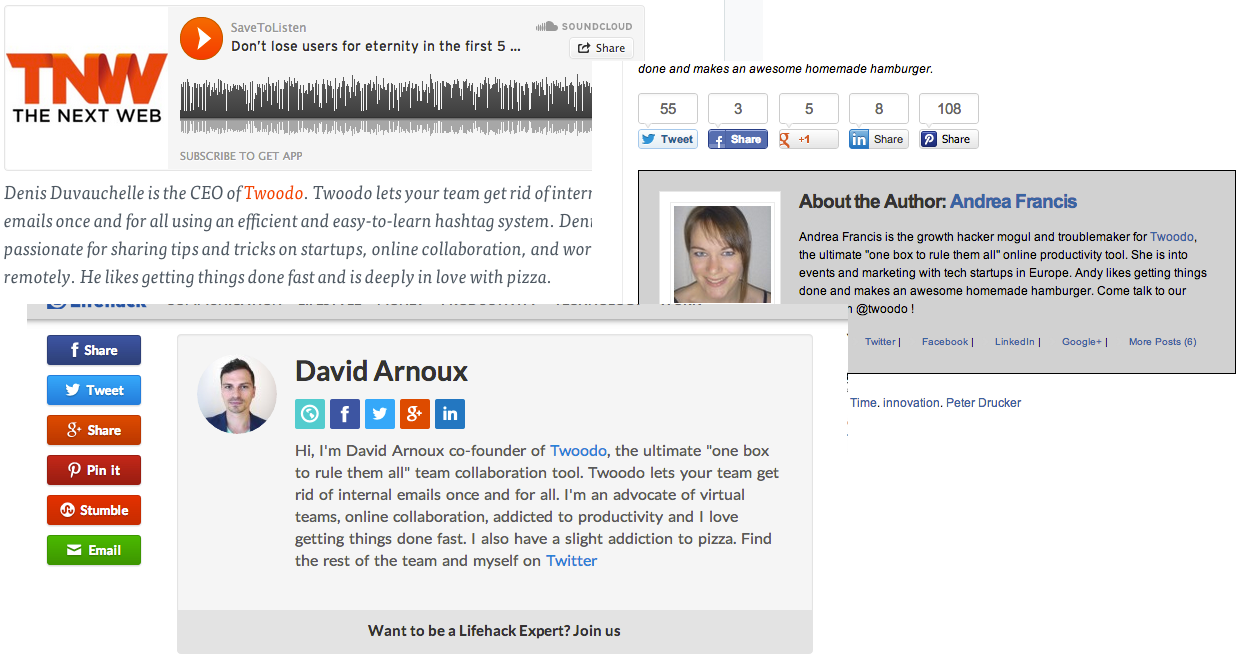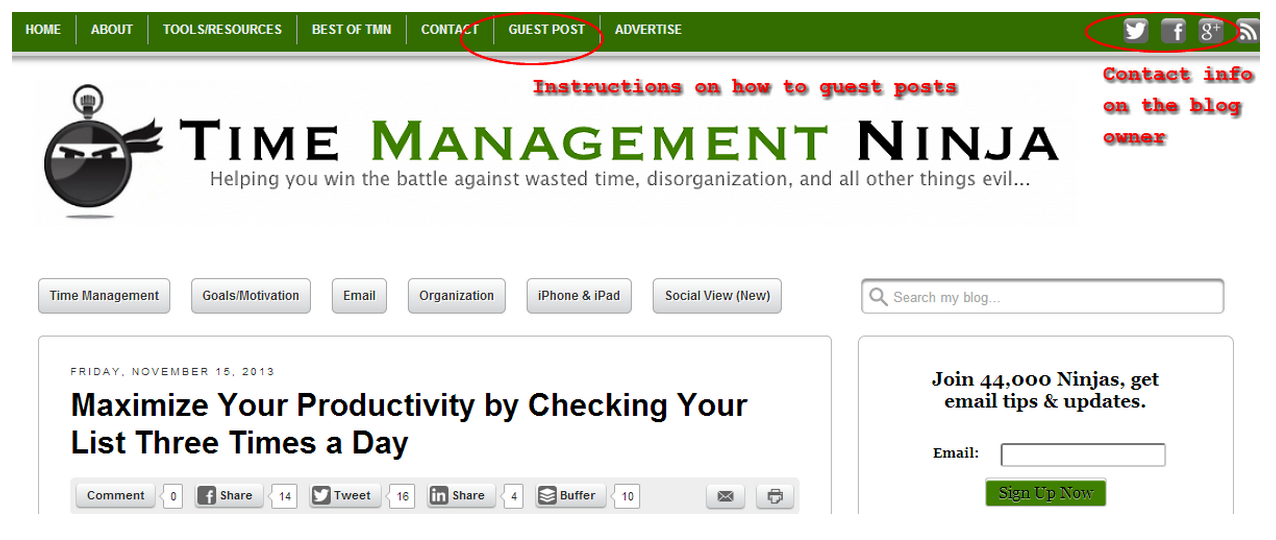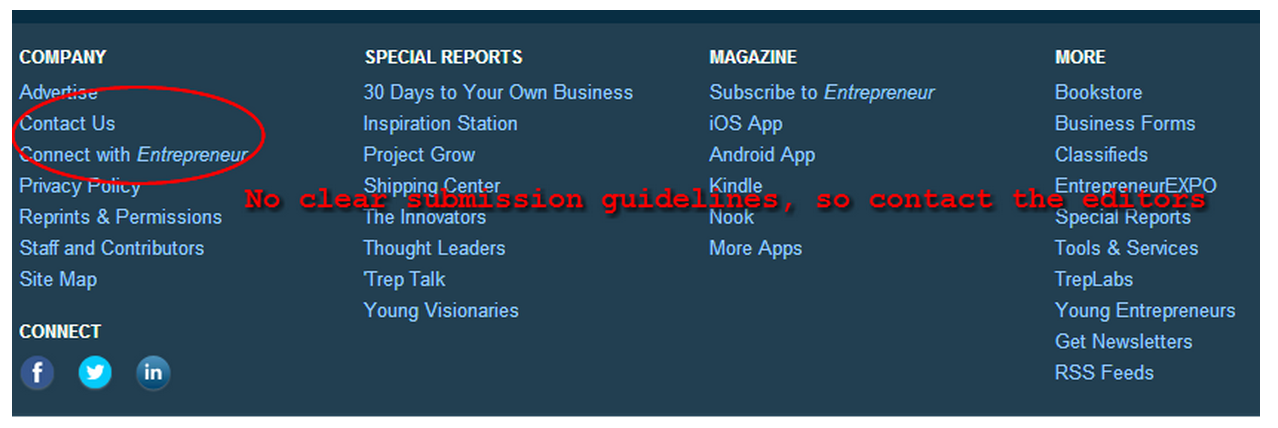This article shows you:
- why guest blogging is an excellent strategy
- a step-by-step guide on how to get started
Why should I care about guest blogging?
If you’re trying to build an online business, guest blogging should be a no-brainer. Guest blogging tips are everywhere for a reason. In the early stages, if the decision should be whether to write content for your own blog or write content for someone else’s blog, (i.e. guest blogging) go with guest blogging. When the time comes to make a serious effort on your own blog, you’ll have improved your writing skills and built up good connections with other blog communities. Basically, it’s a base for better publicity via connections you will have made, communities you will have become known in and impact positively on your SEO ranking.
There’s a great slideshare by Doug Kessler that explains why 2014 will be the year of the content marketing deluge. Everyone’s doing content marketing so it’s becoming extremely difficult to get people’s attention and gather an audience. Readers are also putting their guard up and relying more and more on a specific number of online publications. This is why we’ve put together our best guest blogging tips that we learned through hours and hours of experience.
Don’t give up!
Guest blogging, whereby you write content for someone else’s blog or online publication, is an extremely effective way of acquiring quality and continuous visitors for your website. Basically put, if no-one is reading your blog, write for one with a larger audience. In exchange, you are allowed to include a bio with backlinks to your desired webpage (typically the company website and Twitter).
This has a dual effect of increasing your authority on certain subjects and attracting targeted readers to your website. At Twoodo, we set up a guest blogging strategy about four months ago. We went from nowhere to writing for publications like The Next Web, Under30CEO and Lifehack. We’d love to share some lessons from our ongoing journey.
But first…a kick-ass example that inspired us
BufferApp famously grew their website from 0 to 100 000 users in nine months using guest blogging. The team at Buffer (and notably Leo Widrich) have openly described on many occasions how they achieved such rapid results. Guest blogging well-written, informative, interesting and useful advice about Twitter (it was still pretty new back when he started) helped grow the company from an early-stage startup into a fast-growing enterprise with a large audience. They became thought leaders and experts in their niche, and this has built them and their blog a strong audience over the last two years. The content marketing strategy is a powerful example to follow.
Following in Leo’s footsteps, we’d like to share with you the methods, tricks and mistakes we encountered on our way to guest blogging for publications like The Next Web, Lifehack and many other publications.
Step by step guest blogging tips - how did we do it?
1. Find someone on your team who likes writing.
It’s difficult to get guest-blogging right if no-one on your team likes to write. So if you don’t have one, hire someone who loooooves writing. This is critical because decent writing takes time, not to mention the time spent on creating nice images, graphs, illustrations etc. to add meat to the article. Outsourcing is an option, but we personally did not find it to be a good idea. After three tests, the quality just wasn’t there. We wanted someone from within our team, experiencing the company growth to document the steps we took, and come up with interesting and relevant content to our audience.
Bear in mind, the first articles took quite a long time to write compared to four months later. We grew from one OK-ish article a week in the early stages to the two or three high quality weekly articles we achieve now. This can still be improved! We’ve also set up better co-writing and editing processes that increase the quality and speed of article writing.
2. Identify your audience
Before starting to write we sat down and asked ourselves “why are we doing this?”. The answer was pretty clear: we wanted to grow the top of our sales funnel. Increase the number of people landing on our home page. So before asking ourselves what we would write about we first asked ourselves “who are we writing FOR”. We took out our customer personas, put them on a table and started listing all the places where our personas like to hang out on the internet, what they liked to read, who their gods were, what did their gods read etc. These would be the places we’d try to write for.
But this list was still too short and generic. So we used Technorati’s blog directory for a more extensive list of possible blogs. We clearly had our eyes set on reaching the top of that list right from the start.
Technorati results proved a bit overwhelming so we limited ourselves to the first 100 blogs listed in our category, “tech”. We listed them in a spreadsheet (here is a link), and then visited and read each of them and rated them for relevancy from 1 - 4 (did this blog have content related to our topics, was it an active blog, and did it accept guest posts).
Then, we tried out Prismatic and within the categories relevant to us, we read the posts we liked best, noting which blogs they came from. This was a good way to find lesser known blogs that had a respectable audience. Two other good resources for this are Blogmetrics and Alltop. We also read the blogs of our favorite companies for inspiration. They inevitably talk about and linked to blogs they like to read. Here are some examples:
And then of course, Google searches. For example doing a quick search for “best startup blog” brought us to this gem of an article which directed us to a number of great bloggers: http://platformsandnetworks.blogspot.nl/2012/12/managing-startups-best-posts-of-2012.html
Quora also proved to be very useful.
What you are looking for are people or publications who stand head-and-shoulders above the rest in terms of authority. Who are considered experts on this topic? Who generates a lot of buzz when they publish an article on the topic? Search for blogs with lots of active commentary and social shares. Look at the top authors and commentators. These are not only your peers but can also be your audience. These may be your future evangelists. When you have built a relationship with them, you can ask their help for pushing an article to their networks. Groove HQ have an awesome article explaining how they built up their network of influencers and got them involved in what they were writing. I strongly suggest you read it.
3. Identify your expertise
Write about what you know. If this is your first time writing, I’d suggest you write about the pain your website or app is solving. We brainstormed areas of knowledge in relation to our product, and thought about what we could share with the world. It is possible to compile guidelines and advice on something you’ve never practically applied, but authority will stem from hands-on examples and experiences that the team have had. Pro tip: DO NOT write only about what your app does, write about what your audience would be interested in.
One problem we found was finding the time for our product developers and coders to sit down and explain their work, ideas and tips. They have TONS of great stuff locked inside their heads - but no time to go through it. We set up a spreadsheet where they could vote on and suggest articles to write (view it here).
The writer would send to-dos to the rest of the team asking for “brain farts”, tips and tricks on these topics, or links to their favorite resources. What we thought would be short sentences turned into long paragraphs full of rich content. It was then the writer’s job to make it readable. Another good idea is to find complementary topics between teammates and co-write on them. Mutual learning about each other’s jobs and new insights into how to tackle a problem are the positive side-effects of co-writing.
4. Separate the list of blogs into “accepts/does not accept guest posts”
It’s very important to study which blogs accept guest posts, and which ones allow you to have a bio with links. These were where we would choose to write. It’s not always 100% clear whether a blog or publication accepts guest writers.
However, not all websites will have such clear steps, such as the example below. If so, go to their contact page and simply ask them. Better still, pitch an article to them in the same message for greater opportunities.
Download/copy our guest blog preparation template from this link: https://docs.google.com/a/twoodo.com/spreadsheet/ccc?key=0ArweYPmTIiyjdDZ3UHE3dTc1T0xrMDMtUGZhekdSRXc#gid=0
Stumbling block: Sometimes, blogs don’t mention whether they accept posts or not. Try to get ahold of the blog owner’s email or twitter and send a query. Blog articles always have an author which you can look up, and if it’s a one-man blog there will usually be an “about” section giving you that info. A simple search of “[name] email” brought forth a surprising number of them. Also try LinkedIn in-mailing or “[name]@[theircompany].com”
Recap so far: we have someone who loves to write, a list of things we can write about, a list of places we can publish it - all industry relevant to our company.
5. List the blogs in a preferred order
We made a list of where we wanted to be published the most (even if it was outrageously beyond our level) and started contacting them in 48-hour cycles until we were accepted onto a blog. The steps of this cycle are listed in the next points.
6. Guest blog post email template
We designed the initial contact email and email headline that would be sent to the blog owners to grab their attention, and hopefully get accepted. A lot of time was put into this step, and even with this template created a lot of personalization was required for each blog owner we contacted. This skeleton frame ensured we didn’t leave out anything important (and is not to be confused with an automated email scenario). At the top of the email we noted that we were giving 48 hours for the post to be considered or accepted due to time constraints. This was a personal decision based on our rookie experience of waiting two weeks for a rejection email per blog owner, meaning that we went weeks without being published at the start. If you are working through a list of twelve people, and are sticking to emailing them on weekdays, this means it could take up to a month to get one piece published. Here is the link to the email template if you want to use it.
Stumbling block: our initial email had the 48-hour withdrawal at the end of the message rather than the beginning. This did not go down well with one editor of a rather huge online magazine…
7. The follow-up email template
We decided that two days was long enough for our email to be picked up or ignored. To check that we hadn’t been glossed over in the blog owner’s inbox, we designed a “hey did you get our email?” template (see image below). This one was less customised, as it required a friendly query generally inquiring about the initial email proposal. After spending a long time perfecting the first email, we wanted to direct the blog owner’s attention to that one rather than writing another long email. Some people just prefer short emails.
Stumbling block: in hindsight, we should have started using Yesware immediately to get notified when people open your email.
8. Social media
Because of the high profile of the people we were contacting, we chose LinkedIn as the means to send follow-up messages to the email.
Stumbling blocks: In hindsight, we now connect with all these people on Twitter, and tweet the editors of the blogs within 6 hours of sending the follow-up email (after confirmation from Yesware that it was opened) in case we did not stand out from all the other emails. We still use LinkedIn in-mails but maybe not everyone is a fan of using that platform
9. After publishing
We made sure to share the article on all social media, to thank the editor/blog owner publicly (Twitter) and privately (personal email). Every comment made was responded to (thanks to Disqus notifications!). We also set up a Hootsuite search column with the URL of the article for each and every one of the articles. As soon as it was mentioned or shared we send a little thank you tweet. If you are feeling bold, tweet your top influencers with the link and ask them what they think. Submit your article to all the link indexing websites that you found in your preparation stage and push them to all your social networks. Make sure to add 2 - 3 relevant and trending tags (short and long-tail).
Recap so far: email templates made for first and second contact; follow and tweet the influencers on Twitter; order the list of blogs by preference and contact them in turn every 48 hours; thank those who accept us and promote them and the article
10. Measuring your success
It’s a fantastic feeling when someone tells you “Hey that’s an awesome piece, and I’d love to publish it”. But in lean startups, it’s not just about gaining authority. It’s got to be a profitable return on the time spent writing, editing, publishing and promoting it. How do you measure the ROI? This is where metrics come in.
We use Google Analytics, Mixpanel and a tracker that we insert in our author bios, so that we can track how many hits we get from each blog we are published on. You can also use Bitly links. If we are not acquiring enough unique visitors and signups from a website after three posts, we go back to the drawing board. We discuss if it is our writing quality or if the community on this blog was a poor fit for our material and decide the next move.
Lessons from being naïve
- Your first articles probably suck
- A lot of people don’t care about what you write at the start
- The “official writer” can be limited to what he/she knows.
- Not everyone on the team likes writing about what they know
- Many blogs have no traffic or engagement - finding good ones takes time
- Thousands of writers compete to get on the big websites
- It takes AGES for some blog owners to reply
- Make sure you contact the right people. You can usually find a list of authors of a publication.
- August (or holiday time in general) - nobody is in the office
- Even after being accepted, you may wait up to two weeks before seeing the piece published
- The editors can change some stuff (e.g. take out links to your website, screw with your SEO efforts)
How to stand out:
- bold, interesting headlines
- headlines that offer solutions to real problems
- be noisy (but not annoying) on social media
- make sure the piece you submit superbly matches the content to the images and links
After starting small, three months later we had become guest bloggers on multiple websites. We were driving strong and continuous traffic to the website and we felt we had enough authority and know-how built up to get an article on The Next Web. An article on the Next Web typically brings us 3000 unique visitors within days and about 100 new signups to our tool - a great ROI from three days of on-and-off co-writing and editing. We’re now continuing to write for The Next Web and aiming for other large online publications.
Takeaways from the guest blogging experiment
- Our major lesson was that “content is king” is for those who are established authorities on subjects. In order to maximise our visibility in search results, we also started to apply better SEO tactics, but without ruining the content.
- Relationship-building takes time and consistency, and there is absolutely no shortcut to that
- Accept that there will be many hit-and-misses at the beginning
- Eventually you need to decide on whether you will write one article for multiple blogs or become a regular contributor to a few blogs. Use metrics to track where the most conversions are coming from!
- You need to decide what goes on your own blog and what gets placed on other blogs - does the best stay or go?
- It’s worth the effort
ALSO! Don’t hesitate to use this awesome checklist when writing your articles and promoting them..















